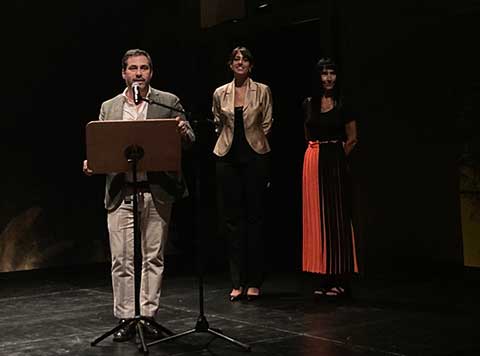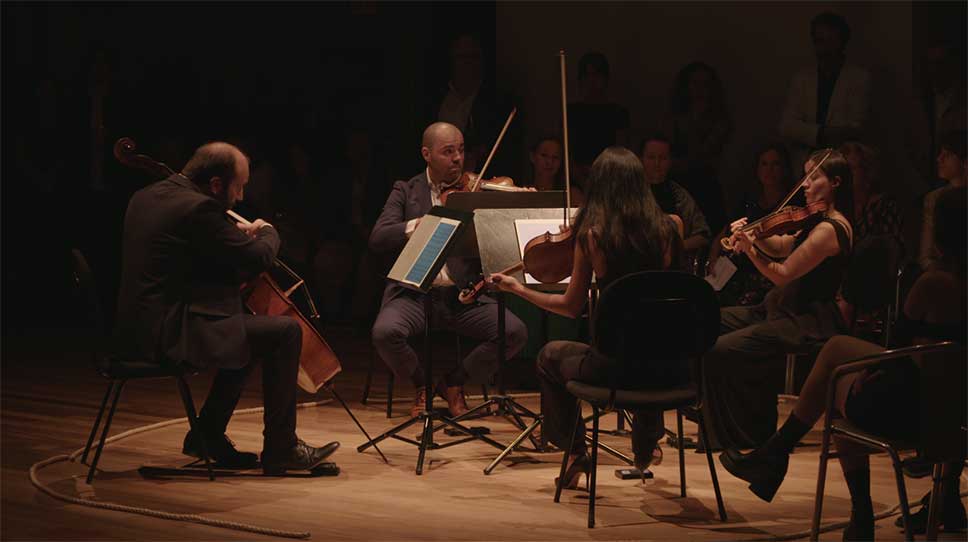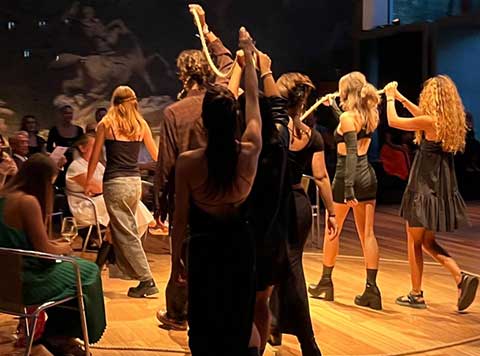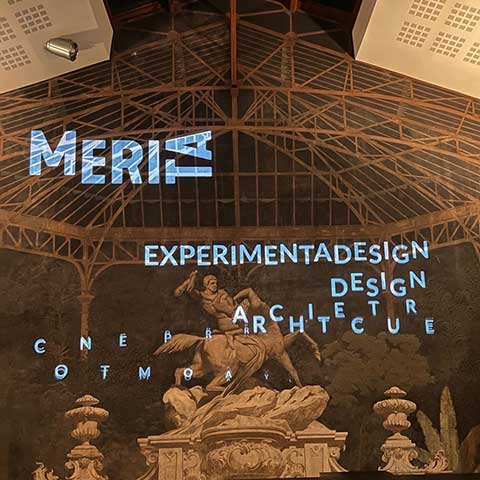Space, Place and Music Interactions
Training | December 21, 2023
Author: experimentadesign
As one of the international partners of MERITA in charge of the development of the educational courses, experimentadesign seeks to open doors of experimentation and innovation within the realm of classical music by introducing different fields of action related to different fields of design and architecture. As a cultural association focused on the areas of design and architecture, the idea of space is crucial to experimentadesign’s practice, considering its importance for both disciplines and for their interaction with other creative fields. It was through this lens that experimentadesign challenged MERITA’s quartets to consider new and innovative ways to use and think of the space in their projects. The theme presented by experimentadesign is “Music, Space and Place”, which reveals countless possibilities of exploration in regards to performance and interpretation, the relationship between music and space and venues, acoustics, stage design and light design, audience interaction and engagement, environment and culture.
Evidently, there is plenty of source material that may serve as inspiration or starting point to a case study related to space and place in classical music – however, the challenge here is to think about how to deconstruct a string quartet performance or how to incorporate new elements into the performance, interpretation or staging. In the traditional and historical sense, string quartets follow a rigid structure that applies to their siting disposition, their interaction with one another and their audience – important elements that define the general form and feeling of the performance. Therefore, experimentadesign encourages the quartets to think deeply about the ritual of performing, the influencing role of the stage or even the venue on the interpretation, as well as audience engagement. Parallelly, experimentadesign also aims for each of the quartets to reflect about music, space and place beyond the context of classical music, by thinking about the proximity that exists between architecture and music, the composition of the scenic space, theatre, performance, language and the visual arts, for example.
 The first opportunity to explore these ideas and bring them to life arose last October 12th, with the organisation of a dissemination and communication event prepared on the occasion of the Transnational Project Meeting of the MERITA project, hosted by experimentadesign in Lisbon. The event took place in the heart of Lisbon, at the São Luiz Municipal Theatre, a cultural institution anchored in the performing arts, recognised for its varied array of proposals and programmes, challenging artists through commissions and co-productions. Besides the international partners of MERITA, the presentation was attended by governmental entities, relevant figures from cultural institutions, and representatives of experimentadesign’s local partners, and included speeches from the President of experimentadesign, Guta Moura Guedes, the Councillor for Culture of Lisbon City Council, Diogo Moura, and the representative of Europe Project Lab, Diletta Paoletti.
The first opportunity to explore these ideas and bring them to life arose last October 12th, with the organisation of a dissemination and communication event prepared on the occasion of the Transnational Project Meeting of the MERITA project, hosted by experimentadesign in Lisbon. The event took place in the heart of Lisbon, at the São Luiz Municipal Theatre, a cultural institution anchored in the performing arts, recognised for its varied array of proposals and programmes, challenging artists through commissions and co-productions. Besides the international partners of MERITA, the presentation was attended by governmental entities, relevant figures from cultural institutions, and representatives of experimentadesign’s local partners, and included speeches from the President of experimentadesign, Guta Moura Guedes, the Councillor for Culture of Lisbon City Council, Diogo Moura, and the representative of Europe Project Lab, Diletta Paoletti.
In line with the programme’s core subject, the presentation integrated a string quartet performance from an ensemble of Orquestra Metropolitana de Lisboa. They interpreted “Llaços, Contradanças e Descantes”, a bucolic composition by Portuguese composer Eurico Carrapatoso from 2016, inspired by a specific natural space, the mountains of the north of Portugal.

Instead of utilising the formal stage that existed in the room, experimentadesign seeked to set up an informal stage composition through the creation of a symbolic place, subverting the rules and the structure of the concert hall and challenging the quartet to adapt to a new performative possibility, without a rehearsal. For that we invited eight young design students, from local schools, with no previous experience or relation to performing arts or classical music, also as a way to open the field of classical music to other potential audiences.
The new place for the performance was created in real time within the crowded room, blurring the physical and symbolic boundaries between the audience and the performers. When the lights were dimmed, the eight young design students, who were mixed in with the audience, left the room and returned with 6 long ropes, carrying them with their arms raised upwards, gathering them on the floor and forming an irregular circle, marking a new place inside of the theatre space, among the audience.
 The students then picked up four chairs and four music stands, placing them in a closed circle within the space defined by the ropes, with the stands in front of each chair. Afterwards they formed an entrance to the circle with their own bodies, as four stood on each side, creating a path for the musicians to enter the small immaterial stage, who followed them promptly. The circle was then illuminated and the musicians began to play, surrounded by the public.
The students then picked up four chairs and four music stands, placing them in a closed circle within the space defined by the ropes, with the stands in front of each chair. Afterwards they formed an entrance to the circle with their own bodies, as four stood on each side, creating a path for the musicians to enter the small immaterial stage, who followed them promptly. The circle was then illuminated and the musicians began to play, surrounded by the public.
By incorporating this short and minimal intervention to the string quartet performance, experimentadesign was able to tackle some ideas related to space. Initially, the small intervention was disruptive, affecting the order of the room by interrupting conversations and breaking up groups of people, but the public soon became involved and complicit in this choreography – a kind of introductory ritual, which gained form as it unfolded, turning a small circle into a stage and the crowd into an audience. Above all, the performance reflected experimentadeisgn’s ethos, based on the consolidation of innovative ideas, experimentation and research. The challenge here was to stir the general ambience of a formal presentation by thinking about the theme of “Music, Place and Space” and finding innovative ways to push the boundaries of performance making, stage design, and audience engagement. The work experimentadesign aims to develop with the quartets is to expand on these ideas, transporting classical music to other realms and envisioning unprecedented concerts, feelings and forms of playing.
 _ experimentadesign is a nonprofit knowledge production and project development unit working in design, architecture and culture. Created in 1998 and based in Lisbon, its primary field of action is creativity and contemporary culture with an inclusive and multidisciplinary perspective, combining critical thinking and concept development. Committed to design as a tool for reshaping contemporary society, generating effective change and positive impact, experimentadesign actively pursues responses to the modern-day challenges, both social, human and material, combining creativity, economy, industry, communication, research and innovation.
_ experimentadesign is a nonprofit knowledge production and project development unit working in design, architecture and culture. Created in 1998 and based in Lisbon, its primary field of action is creativity and contemporary culture with an inclusive and multidisciplinary perspective, combining critical thinking and concept development. Committed to design as a tool for reshaping contemporary society, generating effective change and positive impact, experimentadesign actively pursues responses to the modern-day challenges, both social, human and material, combining creativity, economy, industry, communication, research and innovation.
